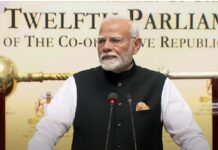India G20: Understanding Infrastructure, Building Cities of Tomorrow
(V. Anantha Nageswaran and Aparajita Tripathi)
One of the immediately observable identifiers of a region’s economic status is the quality of its infrastructure. As a driver of economic growth, infrastructure spending is emphasised by Governments all over the world as a lever for employment and enhanced socio-economic development. World Bank states that a 10% increase in infrastructure spending correlates directly with a 1% increase in GDP over time.
After the G20 was formed in 1999 to deliberate on global economic and financial issues in the wake of the Asian crisis, it was thought that given the Group’s combined population and economic strength, topics for discussion under its ambit must be expanded. Thus, in 2009, the Group was designated the ‘premier forum for international cooperation’ at a Leaders’ level. Infrastructure was recognised as one of the developmental pillars, finding a strong footing in the 2012 Los Cabos Summit, which emphasised a strong correlation between infrastructure investment, productivity and standard of living.
Since then, the topic has not only garnered much interest but also generated a substantial body of work for advancing the cause of infrastructure, especially around financing, investments and leveraging private sector participation. The year 2014 saw the establishment of institutional support for infrastructure through the Global Infrastructure Hub (GI-Hub) based out of Australia and the Global Infrastructure Facility (GIF) by World Bank.
In parallel, as the world moved towards recognising the importance of infrastructure, developments,such as the emphasis on PPP or Public Private Participation, were also captured by the Infrastructure Working Group (IWG) in G20. It is now well recognised that despite significant public spending on infrastructure worldwide, further scaling up will require a concerted effort from different financing sources – the private sector, multilateral and bilateral and other international organisations. Financial Instruments should be well diversified, and the climate for private participation must be enabled. This was also well captured in the successive Presidencies of Turkey, China and Germany. The necessity of recognising Infrastructure as a separate asset class was undertaken in the Argentinian Presidency of 2018.Since then, G20 has pushed for incorporating sustainability in infrastructure through different modes such as quality indicators, using technology for informed decision-making and scaling up private participation.
With the baton passed to Indian Presidency in 2022, the infrastructure agenda is seen through the lens of ‘Vasudhaiv Kutumbakam’ or one world, one future. India’s new contribution to IWG will be the flagship priority of ‘Financing Cities of Tomorrow’, which has never been addressed earlier exclusively in G20.
By 2050, nearly two-thirds of the world’s population will live in urban areas, so a wave of next-generation urbanisation will span across continents within developing and developed countries. This has the potential to ramp up global growth significantly due to the strong correlation between urbanisation and GDP. With over 80% of GDP generated in cities, urbanisation can be a bright spot if it is well-managed and sustainably oriented.
In the last few years, India has advanced the work in urban cities through the policy of saturation of provisioning of urban utilities, be it housing under Pradhan Mantri Awas Yojana (PMAY), sanitation (Swachh Bharat), drinking water (Har Ghar Jal), urban infrastructure reinvigoration (AMRUT), uptake of mass transit options such as metro-BRTS etc.,and technology-based city upgradation (Smart City) etc.
However, going forward, developing and developed countries must look to a future that any country in the world has not yet addressed. Given the Net Zero commitments by countries, the ravaging effects of climate on urban and fiscal resilience and the diverse pool of people who will inhabit future cities, cities of tomorrow must be made sustainable, resilient and inclusive.
As Pune gets ready to host the first IWG meeting under G20 India Presidency in the upcoming week this January, it is a good time to remind ourselves that to address the challenges of the future, cities must substantially take upon a new avatar – self-reliant, self-confident and financially empowered. Municipal governments must look to plan not only the strategy for cities but also find the resources to translate the visions into reality.
A complementary dialogue for municipal commissioners on urban governance in Pune University will accompany the first IWG meeting. Another event around the challenges and strategy of financing for cities of tomorrow will be hosted by ADB. The intended speakers are expected to share valuable insights on how countries can advance sustainable urban development while meeting the priorities of different segments of the population.
In the movement towards the ideal envisaged by this year’s Presidency, what is better than to bring the focus back to the oldest building blocks of the world – the imposing but humble, expansive but regional, connecting but distributed – Infrastructure?
(V. Anantha Nageswaran and Aparajita Tripathi are Chief Economic Advisor and Consultant, respectively, in the Ministry of Finance, Government of India. Their views are personal).
















